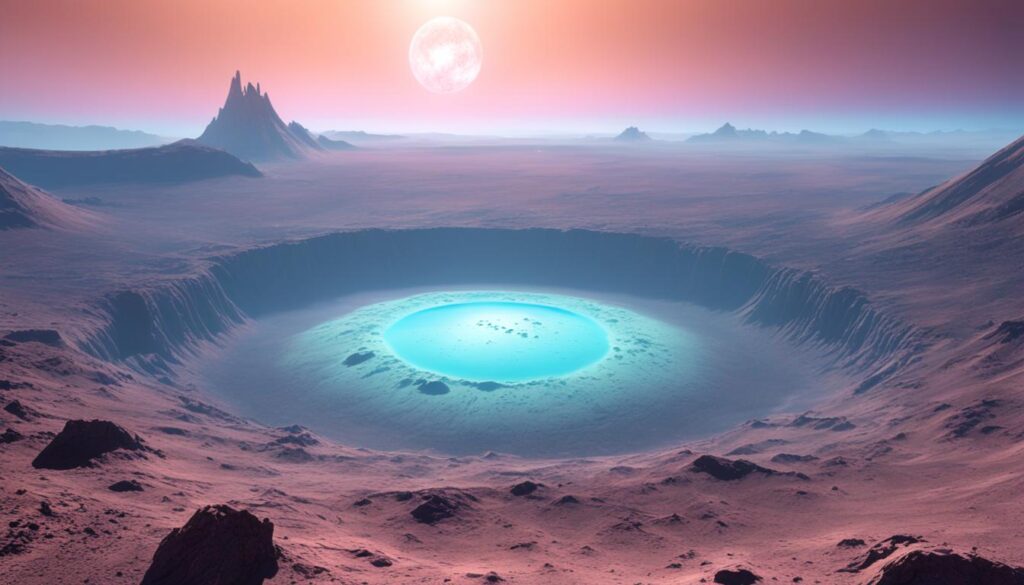Have you ever wondered if there is life beyond Earth? Scientists have been searching for evidence of extraterrestrial life for decades, exploring some of the most unusual and unexpected locations in the universe. This field of study is called astrobiology, and it seeks to understand the conditions necessary for life to exist on other planets.
In this article, we will delve deeper into the search for extraterrestrial life, exploring astrobiology and the strange places scientists believe we might find alien organisms. From the depths of oceans to the icy moons of distant planets, the quest for life beyond Earth continues.
The Quest for Alien Life
For centuries, humans have been fascinated by the idea of life beyond our planet. This has led to a dedicated search for signs of extraterrestrial life, with significant resources being allocated to this endeavor. The quest for alien life is focused on the search for extraterrestrial intelligence or any form of life that may exist beyond Earth.
Scientists have developed several methods and initiatives to detect extraterrestrial civilizations. These methods include:
| Method | Description |
|---|---|
| Radio Searches | Radio astronomers search for signals from space that seem unnatural and could indicate the presence of extraterrestrial intelligence. |
| Optical Searches | Astronomers use telescopes to search for signs of life on other planets, including molecules, light, and other substances. |
| Missions to Other Planets | Exploratory missions to other planets or moons can provide clues about the possibility of extraterrestrial life. |
Despite the immense progress made in the search for extraterrestrial life, no conclusive evidence has been found yet. However, the search continues, with new ideas and theories being put forward. One such idea is the possibility of life in extreme environments, such as Europa, a moon of Jupiter, where there may be subsurface oceans that could sustain microbial life.


“The search for extraterrestrial life is a never-ending quest to uncover the secrets of the universe and understand our place in it.”
The search for alien life is a captivating endeavor that continues to push the envelope of human understanding. It drives us to explore the mysteries of the universe and contemplate the possibility of life beyond our planet.
Unidentified Flying Objects and UFO Sightings
For decades, people have reported sightings of unidentified flying objects (UFOs) in the sky, sparking numerous theories about their origin and purpose. While some believe that these sightings are proof of extraterrestrial life, skeptics argue that they have more mundane explanations.
Despite this debate, UFO sightings continue to fascinate and intrigue people around the world. Scientists and researchers have studied these phenomena extensively, hoping to uncover the truth about these mysterious objects.
| Date | Location | Description |
|---|---|---|
| February 24, 1942 | Los Angeles, California | Multiple sightings of an unidentified object in the sky, resulting in widespread anti-aircraft fire and a blackout across the city. |
| November 14, 2004 | San Diego, California | U.S. Navy pilots reported sightings of Tic Tac-shaped objects flying at seemingly impossible speeds. |
| December 16, 2017 | Pentagon | The Pentagon confirmed the existence of a secret UFO investigation program that had been running from 2007 to 2012. |
These sightings raise questions about the potential connection between UFOs and extraterrestrial life. While there is no concrete evidence to suggest that these objects are of alien origin, their appearance and behavior continue to intrigue scientists and researchers.
“The phenomenon of UFOs is real. I know that there are scientific organizations that study the phenomenon.”
Astronaut Gordon Cooper
Some proponents of the extraterrestrial hypothesis have pointed to alleged sightings of extraterrestrial spacecraft, such as the 1947 Roswell incident, as evidence of their existence. However, the lack of verifiable evidence has led many to dismiss such claims as mere speculation.
Despite this, the search for answers continues. Scientists and researchers will undoubtedly continue to study these phenomena in the hopes of uncovering the truth about UFOs and their potential connection to extraterrestrial life.


Space Exploration and the Search for Life
The search for extraterrestrial life has long captivated the human imagination, and the study of space exploration has been a major contributor to this quest. As humans have ventured further into space, they have gained valuable insights into the potential for life beyond Earth.
One of the most notable missions in the search for extraterrestrial life is the Mars Exploration Program, which has been ongoing since the 1960s. The program has launched numerous missions to the Red Planet, including the recent Perseverance rover, which landed in February 2021. The data collected by these missions has revealed tantalizing clues about the past and present potential habitability of Mars.
In addition to Mars, other celestial bodies in our solar system have been studied for their potential to harbor life. For example, the icy moon Enceladus, which orbits Saturn, has been shown to have an ocean beneath its surface, providing a potentially habitable environment for microbial life. Similarly, the Jovian moon Europa is believed to have a subsurface ocean.


Outside of our own solar system, space exploration has allowed astronomers to identify several potentially habitable exoplanets. The Kepler mission, launched in 2009, discovered thousands of exoplanets, some of which are thought to be located in the habitable zone of their star systems. This means that these planets could potentially have the right conditions to support life.
“Space exploration has given us a new perspective on our place in the universe and expanded our understanding of the possibility of life beyond Earth.”
Missions and Discoveries
Here are a few notable missions and discoveries in the field of space exploration and the search for extraterrestrial life:
| Mission/Discovery | Date | Notes |
|---|---|---|
| Viking 1 and 2 | 1976 | First successful Mars landings, conducted experiments to search for signs of life |
| Europa Clipper (proposed) | 2020s (planned) | Mission to study the potential habitability of Jupiter’s moon Europa |
| Titan Mare Explorer (proposed) | 2020s (planned) | Mission to study the seas on Saturn’s moon Titan for signs of life |
| TRAPPIST-1 System | 2017 | Exoplanet system with seven planets, three of which are located in the habitable zone |
These missions and discoveries highlight the continuing importance of space exploration in the search for extraterrestrial life. With ongoing advancements in technology, scientists hope to deepen our understanding of the conditions that are essential for life and potentially discover evidence of life beyond our planet.
Astrobiology and Microbial Life on Other Planets
Astrobiology is a multidisciplinary field of study focused on understanding the origins, evolution, distribution, and future of life in the universe. A significant part of this study is the search for microbial life on other planets. While the prospect of discovering intelligent life is exciting, scientists believe that microbial organisms are the most likely form of extraterrestrial life we may encounter.
One of the main challenges in the search for microbial life is identifying habitable environments. Given that life on Earth thrives in a diverse range of habitats, scientists are investigating the potential for habitable environments on other planets. They are especially interested in environments characterized by extreme temperatures, pressure, and radiation, where microbial organisms could potentially adapt and thrive.


Moreover, astrobiologists are also exploring the possibility of life on the icy moons of planets in our solar system, such as Jupiter’s Europa and Saturn’s Enceladus. These moons are thought to have subsurface oceans which could potentially harbor life.
| Extreme Environments | Potential Microbial Life |
|---|---|
| Highly acidic environments | Acidophilic microorganisms |
| Extremely hot environments | Thermophilic microorganisms |
| High-pressure environments | Barophilic microorganisms |
| Deep-sea hydrothermal vents | Chemosynthetic microorganisms |
As our understanding of the universe and its potential for life expands, so too does our ability to search for extraterrestrial organisms. With new technological advancements, the search for microbial life on other planets is growing more sophisticated and promising.
Extreme Environments for Alien Life
When it comes to understanding life beyond Earth, scientists must consider that alien organisms may exist in environments that seem unlivable to humans. In fact, some of the most extreme environments on our own planet are home to a variety of resilient life forms.
For example, certain bacteria can thrive in extremely hot temperatures, such as those found near deep-sea hydrothermal vents or in geysers. Other microorganisms are capable of surviving in highly acidic conditions, such as those found in mines or in Yellowstone’s geothermal pools. Meanwhile, some organisms can withstand subzero temperatures and even survive in the vacuum of space.
Considering that the universe is home to incredibly diverse and sometimes unimaginable environments, the potential for alien life to exist in extreme habitats is high. Future studies should continue to explore these types of environments for potential signs of extraterrestrial life.
The Strangest Places for Extraterrestrial Life
As astrobiologists continue to search for signs of extraterrestrial life, they have set their sights on some of the most unusual and unexpected locations in the universe. Here are some of the strangest habitats for extraterrestrial organisms:
| Location | Conditions | Potential for Life |
|---|---|---|
| Deep Oceans | Extreme pressure, no sunlight, cold temperatures | Possibility of microbial life near volcanic vents |
| Atmospheres of Gas Giants | High pressure, extreme cold, toxic chemicals | Potential for floating microbial life forms in the upper atmosphere |
| Subsurface Oceans of Icy Moons | Extreme cold, high pressure | Possibility of microbial life near hydrothermal vents or under the icy surface |
| High Radiation Environments | Extreme radiation levels | Possibility of extremophilic organisms that can withstand radiation |
These strange habitats offer potential avenues for discovering extraterrestrial life beyond what we previously believed to be possible. As scientists continue to explore these and other remote corners of the universe, the possibilities for finding life beyond Earth continue to expand.
Conclusion
In conclusion, the search for extraterrestrial life is a topic that never ceases to capture the imagination. Astrobiology, the study of life in the universe, has revealed some exciting possibilities, and the ongoing research continues to push our understanding of the cosmos. From the depths of oceans to the icy moons of distant planets, scientists are exploring the strangest and most extreme places where extraterrestrial organisms could potentially exist. The potential for microbial life in harsh and inhospitable environments highlights the resilience of life and its ability to adapt to even the most challenging conditions. It is this spirit of exploration that drives the search for extraterrestrial life forward, and we can only imagine what discoveries lie ahead.
